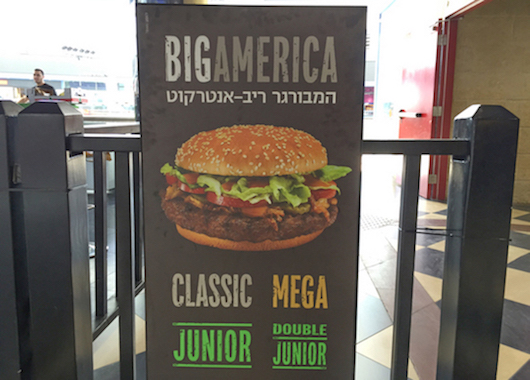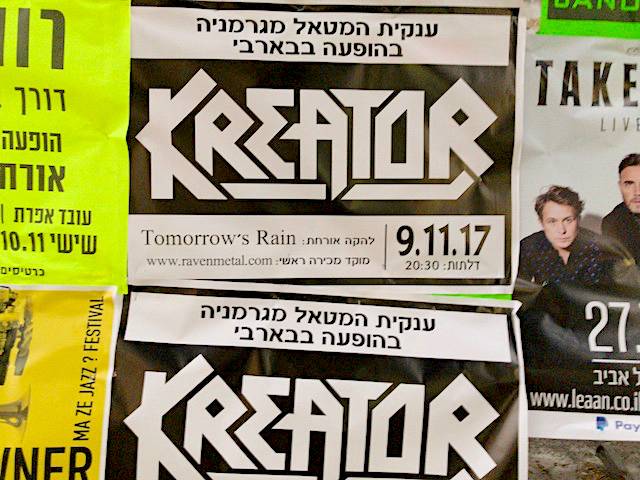In the mall adjacent to Israel’s Supreme Court in Jerusalem, you’ll find this giant image of a hamburger — no cheese, naturally — branded as “Big America”. It’s hard to imagine a better visual allegory for the relationship between the United States and the embattled nation which receives so much of its annual giving, if that’s what you want to see. But the reality is more complicated.
For one thing, that special relationship has never been more strained. As the Israeli political establishment has drifted further and further right during Barack Obama’s years in the White House, the widely dispersed notion that Israel merely acts as a proxy for American foreign policy is increasingly difficult to sustain. The barely concealed disdain that Benjamin Netanyahu and his cronies hold towards the American President and the cool hostility with which the Obama Administration has come to respond to them suggest that “Big America” may have shrunken to the size of a White Castle slider.
It isn’t simply tensions between Israel and the United States that contest the accuracy of this allegory, though. Yes, there are many Americans in Israel and many Israelis in the United States. And, yes, whatever the nations’ political differences, there are a great many people who still regard both of them as “family”. But the selling of American culture — or, if you prefer, anti-culture — can be witnessed pretty much everywhere you go in the developed world.
More than that, the fact that it needs to be promoted in this manner indicates that there is work to be done in sustaining Israeli interest in quintessentially American products, just as there is in China, France and Kuwait. The American Dream may still retain enough of its traditional power to lure immigrants from all over the globe, but its transubstantiation into metonymically consumed commodities is by no means guaranteed.
In other words, the implicit injunction to eat, hear or watch the embodiment of Big America is not a testament to the unquestioned success of cultural imperialism, but to the fact that it doesn’t proceed naturally. Indeed, even within the United States, more and more effort is spent on advertising to convince consumers that it is patriotic to purchase what the average American — that fiction of corporate statisticians — is buying.
Yesterday, I arrived in the San Diego metropolitan area on Memorial Day. Long dominated by the presence of the American armed forces, I expected it to be awash in a frenzy of both literal and figurative flag-waving on that most nationalistic of holidays. And surely it was, in some places. But I found myself in one of those high tech-fueled northern suburbs where, even though it is only a few miles from the U.S. Marine Corps’ massive Camp Pendleton, the primary motivation for consumers seems to be forgetting that they anyone might consider them part of Big America.

Hungry after the long drive, I searched for something to eat in a strip mall full of the sort of convenience-first ethnic restaurants that have come to replace stalwarts like McDonald’s, Taco Bell and Kentucky Fried Chicken just as surely as the cars in the parking lot are primarily substitutes for Ford, Chevrolet and Chrysler. Nothing spoke to my desire for comfort food, though, until I finally spotted a burger joint.
Although this place sold burgers, fries, sodas and milk shakes however, everything about its branding implied an effort to complicate the notion that these foods are first and foremost “American”. First, the design motif was executed in green, a color with strong anti-nationalist associations. Second, items in the menu were described, as is so often the case these days in businesses that cater to the upper middle class, in terms of their regional and local sourcing, as if to reinforce customers’ sense that they aren’t buying the mass-produced ingredients of indeterminate origin that prevail at fast food chains. And finally, taken together with this other evidence, the name of the restaurant, Pure Burger, speaks to a dream of freeing its offerings from the taint of stereotypical American food.
At a place like Pure Burger, the very idea of there being a Big America seems both antiquated and a little absurd. The people who eat there might not consciously think of themselves as anti-American, yet their antipathy towards the culture that the majority of their fellow citizens consumes is a not-too-distant relative of its counterpart overseas. The difference is that, while someone still believes that it is possible to sell Big America in Israel or Europe or East Asia, nobody seems to think it can be done in the myopically cosmopolitan suburban lands where the United States still seems like an economic powerhouse.
Not coincidentally, it is in precisely these prestigious zip codes where the majority of recent Israeli immigrants — and Indian and Chinese and European ones, too — are likely to work. For the people who until now have ensured that Israel, for all of its seeming political backwardness, remains radically distinct from its neighbors in the Middle East, Big America is as transparent a myth as Big Israel. Simply put, such traditional conceptions of national identity strike them as irrelevant unless they get in the way of the globalized business culture in which they feel at home.
It should come as no surprise, then, that the Big America burger is itself a sign that some of the United States’ most iconic corporations have had to rethink their mission in order to sustain growth. As McDonald’s has witnessed a steady decline in its domestic sales in recent years, battered by smaller and more nimble franchises perceived to offer better quality products, it has tried to compensate by increasing profits abroad.
In Japan, for example, burgers sold under the Big America rubric feature such counter-traditional ingredients as eggs, cream cheese, and Caesar salad sauce. And in Israel, of course, dairy-based items are not an option, making the classic cheeseburger an impossibility. To sum up, Big America turns out to be a fantasy that itself undermines the conviction that American culture is something that can be exported without modification. What we confront instead is a world where little Americas compete in niche markets, a situation, ironically, not unlike the one in which the United States’ armed forces have found themselves since the end of the Cold War.
Commentary by Charlie Bertsch. Photographs courtesy of Joel Schalit.





